Menu
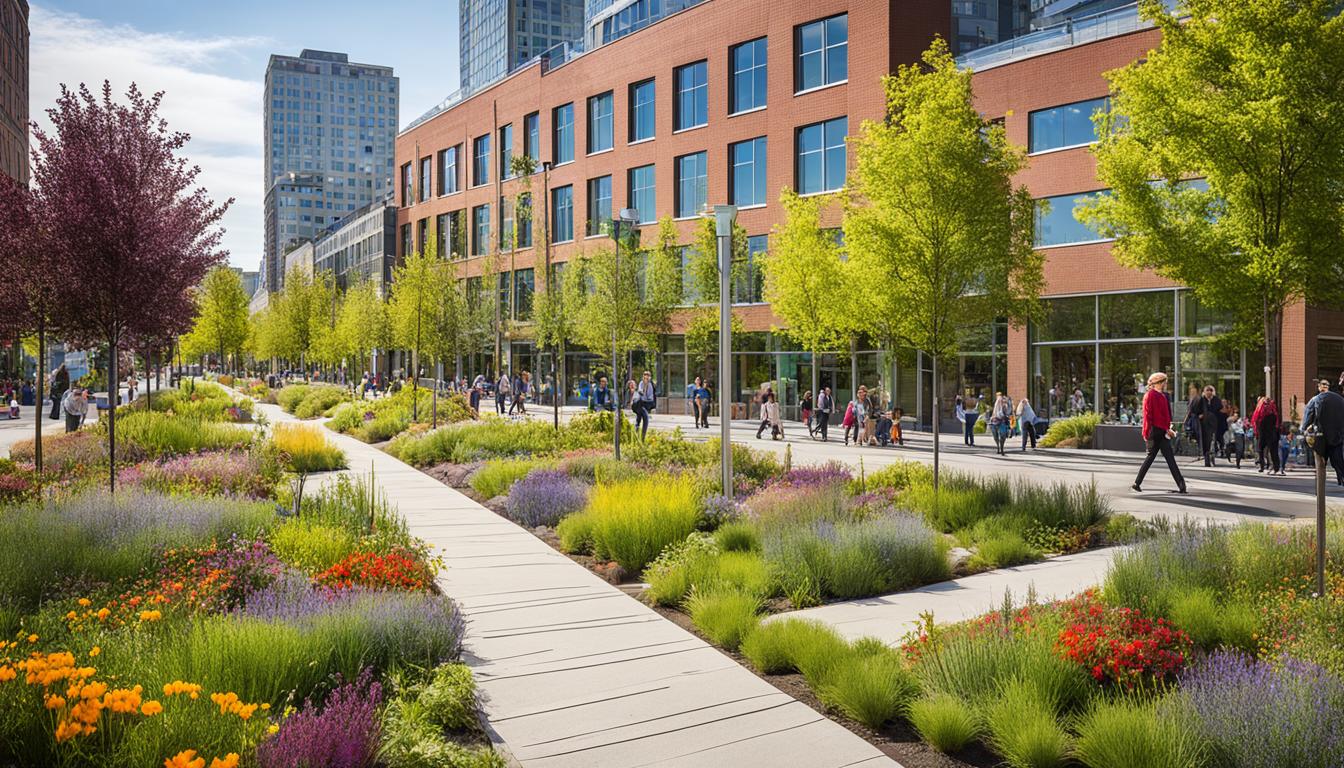
I walk through beautiful, green lands that are our home. I feel closely connected to the tall trees, wildlife, and ecosystems. But, there’s a big challenge: our climate is changing fast. This change puts our biodiversity at risk. It affects our water, the cycles of life, and our health. We urgently need to mix climate resilience and biodiversity strategies.
Our future relies on planning ahead for climate resilience and being eco-friendly. We should learn how ecosystems react to climate change. And we need to make our ways of helping nature stronger. It’s crucial to fight climate change and protect biodiversity. As seen in Wyoming, taking care of rivers and wetlands helps to plan for the future. It’s about making choices ready for new challenges. This includes more natural disasters and changing life cycles. The Fourth National Climate Assessment shows that using science and nature is key. We must protect nature for those who follow us.
The United Nations calls some places, like the United States, “megadiverse.” They hold a lot of Earth’s creatures. This gives us great chances but also tests us on saving life forms and dealing with weather shifts. It’s key to safeguard varied terrains and water systems. They help not just the creatures but provide fresh water, homes for animals, and places we cherish.
Currently, we’re at risk of losing about a million kinds of plants and animals. This threat comes from the quickening impacts of climate changes. We urgently need solid plans to save the environment and adapt to new climates. For example, over 85 per cent of wetlands, which are good at cutting down carbon, already vanished.
The Pew Charitable Trusts lead by example. They focus on making ecosystems strong and connected. Their plans are all about science and cover many angles to fight the crisis in nature. They also think about the lives of over a billion who depend on forests. And they work to keep more than 30 per cent of the Earth green.
Ocean areas like seagrasses are great at taking in carbon. They do this up to four times better than forests on land. They are key in breaking down air pollutants and in keeping sea life rich. Despite taking big hits from climate shifts, these areas are essential.
Enhancing how nature traps carbon could cut a third of all bad emissions soon. So, keeping land like peatlands intact is crucial. They hold twice as much carbon as any forest worldwide. This tells us why we must focus greatly on protecting all parts of our environment. Doing this helps us cope and battle climate threats and secures a future where life flourishes.
Climate change is reshaping ecosystems all over the world. It’s leading to major ecological impacts. By understanding these impacts, we can find ways to lessen the harm and make systems stronger.
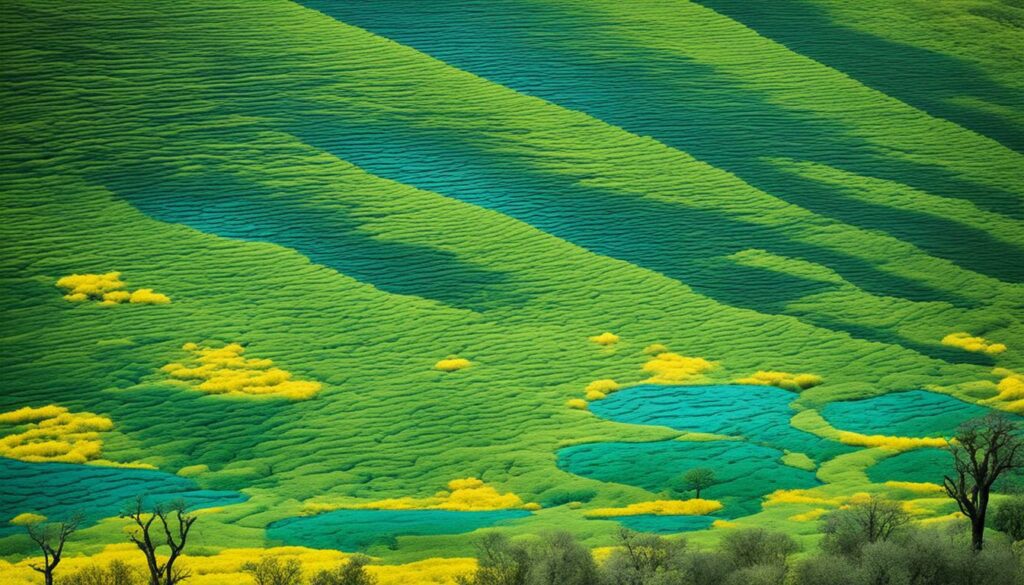
One major impact is changes in streamflow. Warm winters and extreme rain alter the flows. This, in turn, impacts freshwater habitats. It can cause habitat damage and make life tough for species needing steady water.
Managing these habitats and water properly becomes very important.
Climate change also shifts the timing of biological events. This includes when plants flower and animals breed. These shifts can make it hard for species to find what they need. This disrupts habitats.
For example, in the U.S., springs are starting earlier. This change upsets the balance in nature.
| Climate Change Effects | Impact on Ecosystems |
|---|---|
| Changes in streamflow | Increased vulnerability and habitat degradation |
| Phenological shifts | Resource mismatches and disrupted interactions |
| Invasive species spread | Alters ecosystem balance, leading to increased stress for native species |
| Cross-Ecosystem Impacts | Terrestrial, freshwater, and marine ecosystems experience large-scale shifts |
The spread of invasive species is another issue. With climate change, these invasives find new places to thrive. This could stress local species and upset the ecosystem’s balance.
To tackle these problems, we need a big-picture approach. Working environmental strategies into how we manage resources is key. It helps us deal with climate change’s various impacts on ecosystems.
The world is getting hotter, making wildfires more common and worse. This is bad news for the plants and animals that make up our natural world. The UN warns that these fires might double by the end of the century. We need to act fast to protect our environment. The way we deal with this crisis will impact every ecosystem on the planet.
Most wildfires are our fault, caused by things we do or don’t do. In 2021, human actions led to 71% of the big fires in Turkey. The 2019-2020 bushfires in Australia were devastating. They burned an area bigger than the Netherlands and killed about 3 billion animals. These disasters also harm industries like dairy farming. They’ve seen fewer cattle for milk, meat, and wool.
After the fires, invasive plants and animals can take over. A plant called cheatgrass has caused problems in Montana after wildfires. It hurts local wildlife and makes the natural environment less diverse. We need to understand these problems to fight them properly.
Wildfires also hurt our health, causing breathing and skin issues, and even early death. Three and a half billion people, almost half the world’s population, live in areas at high risk from climate change. This is a big problem. Fixing it will keep people and nature safer.
Human activities are changing the Earth and harming wildlife and habitats. The major issue is turning natural grasslands into farmlands. This switch causes a drop of 30% in biodiversity worldwide, especially due to big farms.
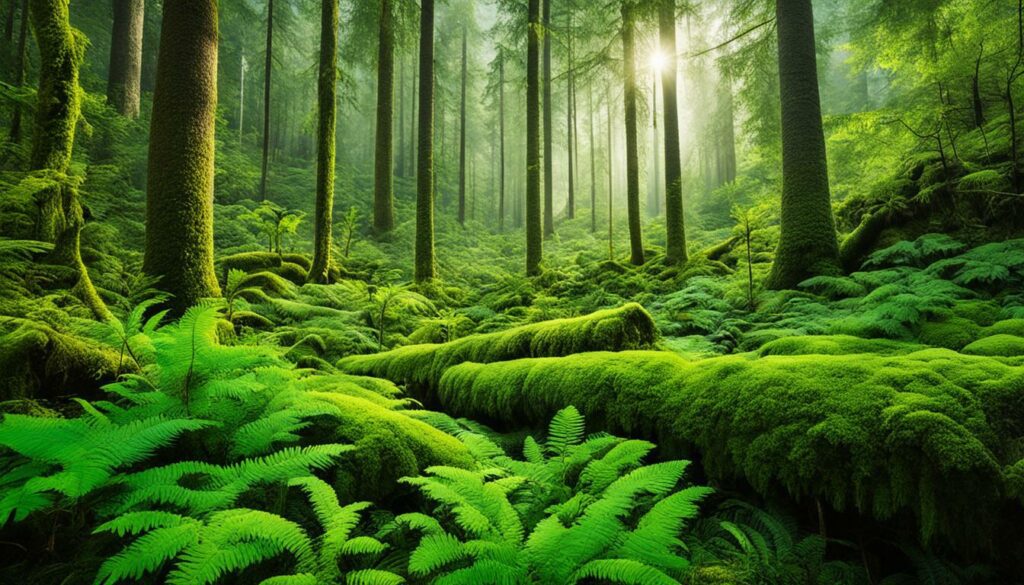
Changing how we use land hurts ecosystems. It ruins where pollinators live and makes climate change worse. The use of pesticides and fertilizers has gone up a lot since 1961, harming our planet. The Prairie Pothole Region’s wetlands are being drained too much, which is bad for birds.
Building cities and towns also takes away from nature. More than 70% of land not covered in ice has been changed by us, reducing wildlife spaces. This lost land, along with the introduction of harmful species through trade and travel, harms nature.
| Factor | Contribution to Biodiversity Decline |
|---|---|
| Land-Use Change | 30% |
| Overexploitation | 20% |
| Climate Change & Pollution | 14% |
| Invasive Species | 11% |
We need to focus on caring for the land better and reducing our environmental harm. This way, we can lessen the bad impact we have on nature. We can also help nature be stronger by protecting its homes.
In the push for ecological and biodiversity conservation, we must focus on adaptive management and scenario planning. Doing so prepares us for the challenges of climate change. Using tools like the Climate-Smart Conservation Cycle and ACT, we can understand our systems better.
Adaptive management allows us to change our conservation methods as we learn more. For example, climate change affects streamflow patterns. This method lets us improve our strategies regularly. The Climate Strategy from USAID highlights the need for better natural resources management.
Scenario planning helps us develop good conservation plans by considering future scenarios. For instance, the Prairie Pothole Region faces warming and wetter times. By planning for this, we can take steps to protect the environment and support species.
“Climate adaptation strategies identified in a workshop included managing land and water use, building watershed health, maintaining species diversity, and prioritising habitat management efforts with a climate change focus.”
Resource managers need to be ready to adjust their plans to climate change. Ongoing research is key, as seen in the workshop by the Wyoming Game and Fish Department. This work helps make our conservation efforts resilient, ensuring their success in a changing world.
| Statistics | Implications for Conservation |
|---|---|
| USAID pledges to support the conservation, restoration, or management of 100 million hectares with a climate change mitigation benefit by 2030. | Illustrates a significant commitment to large-scale natural resource management efforts. |
| Climate change is increasing the frequency and severity of wildfires. | Highlights the need for adaptive management strategies to mitigate these effects. |
| The Climate Strategy supports the implementation of nature-based solutions, such as conservation and restoration of high-carbon ecosystems. | Emphasises a holistic approach to conservation that incorporates adaptation, mitigation, and other co-benefits for biodiversity. |
| USAID recognises the critical role of Indigenous Peoples and local communities in sustainably managing natural resources. | Stresses the importance of localised, community-driven conservation strategies. |
Integrating climate change adaptation into conservation is a big task. It needs us to look ahead and come up with smart plans. The 2018 IPCC report warned that the Earth is already 1.5°C warmer. So, we need quick and good ways to fight climate change. Florida’s plan for the Nature Coast Aquatic Preserve is a good example. It focuses on the future and getting everyone involved.
Research in Nature highlighted that sea animals are in more danger from the heat than land animals. This shows how urgent it is to help whole ecosystems adapt. A PLOS ONE study in 2016 explained why we must plan for the land where rivers flow into the sea. This helps to protect these areas better.
Keeping a close eye on nature and being ready to change our plans is really important. For example, a 2016 study in Biological Conservation talked about how to include climate change in our plans. It helps us face problems that might come in the future. The IPBES also says we must pay attention to fairness and include everyone. They note that climate change hits some people harder, like women, girls, and Indigenous groups.
Managing our environment well in a changing world needs money that can be used in many ways. New data tells us that we have until January 14, 2024, to share our thoughts on how to use money better. These early reports say we really need to spend well to save nature and fight climate change. They stress the key role of conservation programs in making a big difference.
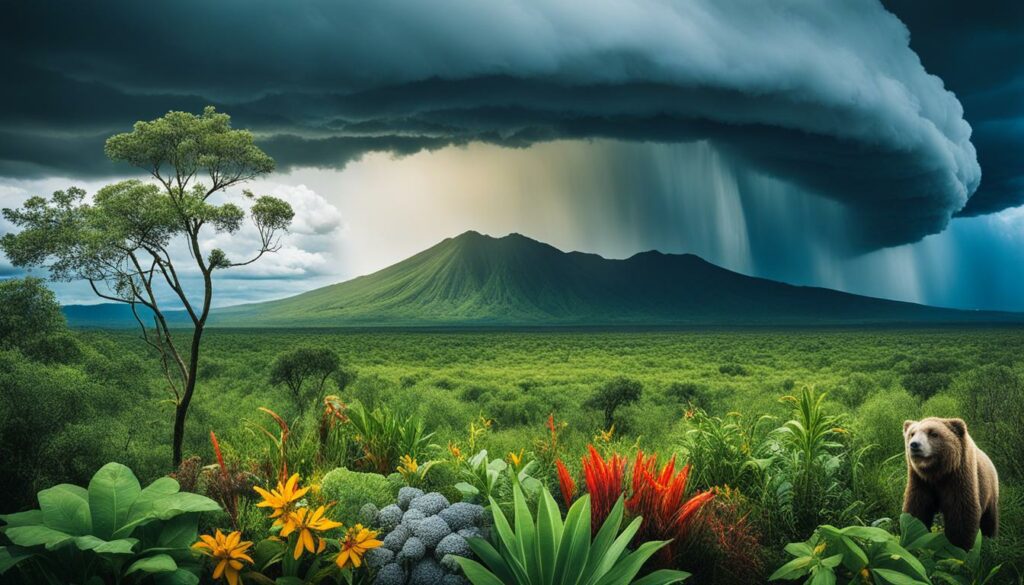
The V-CAP II project is a great example of how these ideas work in real life. It worked in six areas to make existing conservation zones better and create new ones. Over 40 people from different groups joined in, with support from experts in digital mapping. The project also focused on making sure everyone had a part, especially women. This supports the Global Biodiversity Framework’s major goal of caring for our ecosystems in a smart, lasting way.
Nature-Based Solutions (NbS) are a new way to fight the climate crisis. They use natural processes to help. NbS work by restoring ecosystems, managing land sustainably, and saving natural areas. They help people and the planet in many ways.
Nature-Based Solutions use nature to solve problems. They are key to making our world strong against climate change. The IUCN says NbS are vital for reaching climate goals. 102 countries are using these solutions in their plans.
Coastal areas use NbS to protect against floods and store carbon. For example, planting more mangroves helps a lot and costs much less than it helps. The Global Commission on Adaptation says it’s 10 times greater.
Urban areas can also use NbS. Green roofs in Hamburg, Germany, are a great example. They make ecosystems healthier, reduce floods, and lower city temperatures. These solutions are often cheaper than man-made ones.
Using NbS everywhere is a big task. It means we must really know the local conditions to succeed. In Europe, using NbS widely is very important to combat climate and biodiversity issues at once.
| Statistics | Details |
|---|---|
| CO2 Removal Potential | Up to 10 Gt of CO2 per year by 2050 |
| Cost-Effectiveness | Natural projects are 2-5 times more cost-effective |
| Global Adoption | 102 nations include NbS in NDCs |
| Mangrove Restoration | Benefits exceed costs by a factor of 10 |
Overall, Nature-Based Solutions are a powerful and affordable way to tackle climate challenges. They include restoring ecosystems and using nature to our benefit. These solutions are key in fighting climate change.
Conserving nature is key to keep our water, protect wildlife, and care for our planet. As the world changes, it’s more important than ever to manage water wisely. This helps keep our water clean and safe for everyone.
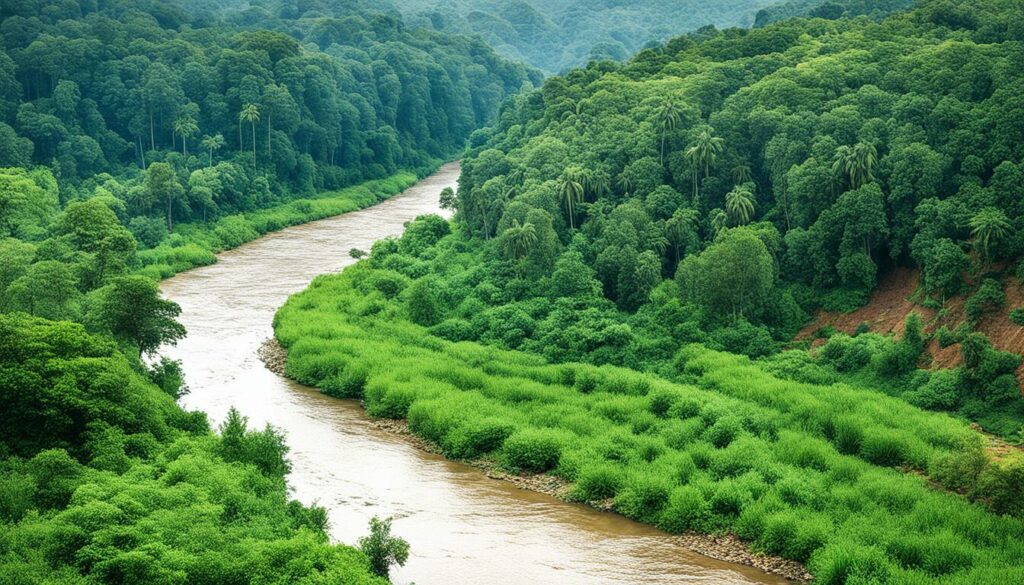
Management of water is vital not only for our use but also to save wild places. It’s crucial to preserve our freshwater areas. Doing so is good for the planet and for our own wellbeing.
Our changing climate affects how much water we have and how clean it is. We must work hard to save our water and protect the life it supports. This is shown in a big US climate report.
In North America, birds are disappearing, and big land animals have less space. Insects are also going down in number. This all shows how important water care and looking after nature really is.
Keeping wild spaces safe and making them better helps water and life in these areas. We can make nature stronger against climate change. This helps the earth in many ways, ensuring we have clean water and healthy land for the future.
Using holistic land management really helps nature and wildlife. It looks at how all the parts of nature work together. This way, our efforts to use the land are better for all living things. It’s a key part of taking care of the Earth and handling the effects of the changing climate.
Holistic land management includes creating landscapes that do many things at once. These can be used for farming, keeping nature safe, and for fun outdoor activities. By doing all this, we make places healthier for plants and animals. This is essential for planning how we use the environment.
People who have learned about holistic management have lots of good stories. They talk about making the ground better, covering it with more plants, and having more kinds of life around. They learn by doing and keep learning from others. It’s a hands-on and supportive way to learn.
Conservation design is a big part of how we take care of the land. It’s about smartly choosing where and how we use land to keep nature strong. This way of planning helps nature cope with changes due to things like climate change. It makes sure animals and plants have safe ways to move.
Around 29 million hectares (75 million acres) of land are managed holistically by over 20,000 farming and herding experts. Projects like Land to Market and EOV are proving that the land is getting better. They show we’re improving the soil, making more homes for wildlife, and helping water soak in better.
People are finding that by looking at the big picture, we can make the environment and the places we live stronger. Holistic land management is good for work, how we make choices every day, and how we interact with others. Those who learn about it say it has a real positive effect on their lives.
It’s very important to build strong communities through biodiversity. This is more crucial now, with many ecological challenges around us. By including everyone in community-based conservation and stakeholder involvement, we can help the environment recover. The United States is special, with lots of different plants and animals. This means we should work hard to keep them safe for both us and the planet.
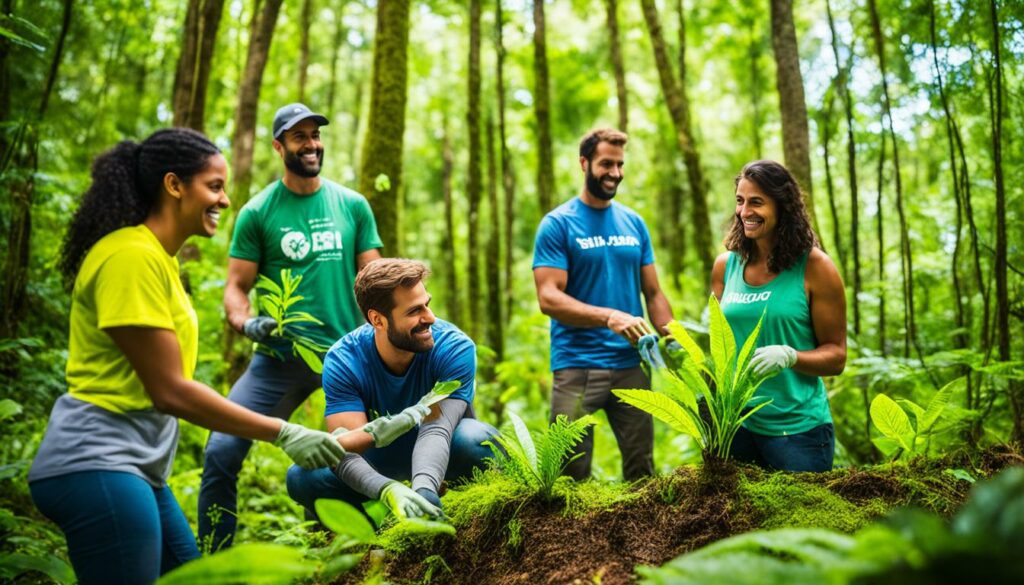
Local communities need to be part of saving our environment. In Florida, for example, they made a plan to protect the environment in 2023. More than 100 people worked on this, putting together a plan that looks at science and what the area really needs. This kind of teamwork makes the area stronger and makes people care more about it.
Working together also helps protect the many creatures and plants that are dying out. This is really urgent since about one million species are at risk. When the community is involved, saving nature becomes more effective. It also helps our environment stay strong and healthy.
Creating places where wildlife can safely cross is a great example. Utah and California have spent a lot of money to build these safe places. They’ve found that these crossings can save many animals from being hit by cars. This saves animal lives and also stops a lot of money being lost.
Here’s a look at how some efforts have helped make our world better for us and nature:
| State | Initiative | Impact |
|---|---|---|
| Florida | Nature Coast Aquatic Preserve Management Plan | Engaged over 100 stakeholders, set science-based goals, improved habitat monitoring |
| California | Wildlife Crossings Construction | Spent nearly $200 million, made it safer for animals and cars, helped animals move |
| Utah | Wildlife Crossings Construction | Spent about $20 million, less people and animals hurt in crashes |
| West Virginia | State Resilience Plans | Worked on protecting against floods with natural ways |
We must focus on working as a community for nature. By doing this, we can make both our communities and our environments strong. This is a win-win for all of us.
Wildlife sanctuaries are key for saving our planet’s variety of life. They help keep the environment safe, especially as climate change worsens. The Greater Chaco Landscape in New Mexico shows why we should protect special places. Yet, real success means not just protecting one spot but linking many for animals and people.
Experts have shared important ways to improve how we protect nature. They focus on five main ideas, especially in colder and milder forests:
Climate change hits protected areas and their wildlife. It brings hotter temperatures, less rain, snow, and higher seas. This hurts where animals live and brings new dangers like invasive plants and pests. We need smart and flexible ways to keep their homes safe.
A big study shows we must manage nature’s protect zones better. It brings together advice from many experts. Doing this can make our efforts stronger and help nature cope with climate change better.
Below is a table that explains the important steps for protect areas:
| Category | Description |
|---|---|
| Ensuring Connectivity | Help animals move between places to keep the gene pool healthy and nature balanced. |
| Protecting Climate Refugia | Find and look after places that give species the best climate as our weather changes. |
| Large over Small | Choose to save big, unbroken nature spots more than small, cut-up ones. |
| Future Critical Areas | Nail down places we know will be super important for nature down the line. |
| Permanently & Temporarily Protected Areas | Mix keeping places safe forever with doing quick, adjust-as-we-go things. |
Working with these top ideas helps us build strong and lasting ecosystems. Wildlife sanctuaries are our main tool to keep the Earth full of life and joy for our children’s children.
The United States works hard to protect biodiversity with strong environmental laws and policies. These help create plans to fight climate change and its impacts. They use science and local knowledge to make sure plans help nature and people.
To protect against climate change, different sectors must work together. Many places, like West Virginia, are making plans to be ready for future disasters. They use solutions like living shorelines to lessen climate harm and save important habitats.
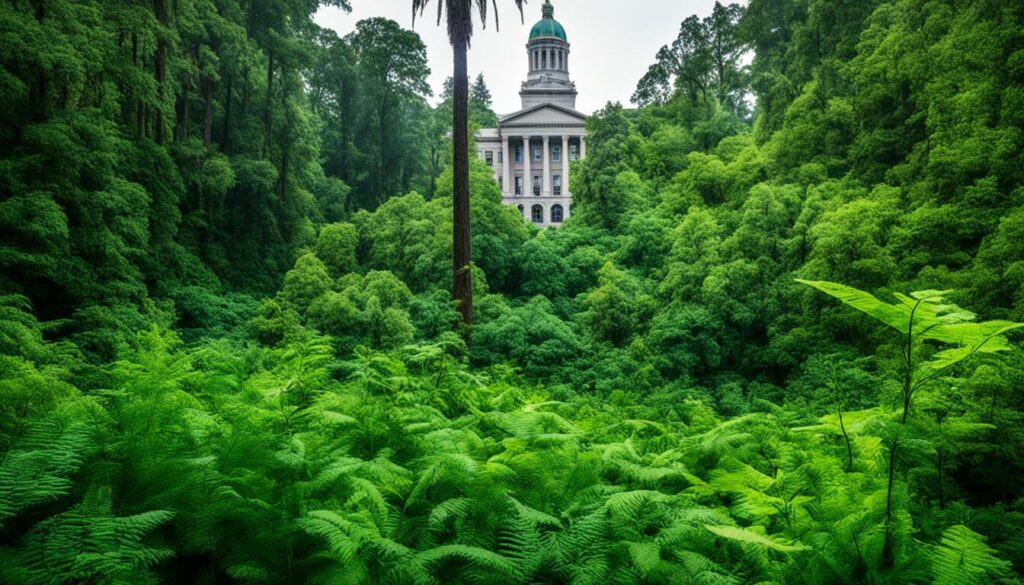
| Initiatives | Investment | Objective |
|---|---|---|
| America the Beautiful Challenge | $1 billion | Supports ecosystem restoration, watershed restoration, resilience, equitable access to nature, and collaborative conservation efforts |
| Multiple U.S. Agencies Partnership | $2 billion | Fish passage and culvert removal to promote healthy aquatic ecosystems |
| USAID Investment in 2021 | $319.5 million | Conserves biodiversity, reduces wildlife trafficking, combats nature crimes, and supports vulnerable communities |
| Global Environment Facility (GEF-8) | $600.8 million | Combats global environmental threats |
The United States is also focusing on nature in economic plans. This includes a roadmap for nature solutions. It guides how to use nature to strengthen the country against climate change.
Indigenous Knowledge plays a key part in decisions, following federal advice. A big study is looking into how nature benefits the U.S. in money, health, climate, and fairness. This will help set goals for keeping nature safe.
The challenges facing our planet today are complex. These include threats to the environment that make it hard to protect biodiversity and be resilient to climate change. It’s important to know half of the world’s economy depends on nature. So, when ecosystems are damaged, it affects our financial stability.
More than a billion people make a living from forests. But, these areas are under a lot of strain from us and the changing climate. This puts their way of life at risk.
Up to a million species could disappear in the coming years. This shows we are in a biodiversity crisis. Also, we’ve lost 85 per cent of wetlands that help fight climate change by soaking up carbon. This makes our fight against climate change even harder.
Climate change is damaging our oceans, land, and freshwater areas. This makes it tough for our planet’s systems to cope. The world is seeing more and more extreme effects because of this.
Rising temperatures have already harmed coral reefs by 50%. Forests, covering over 30% of Earth, help control the climate. But it’s not just forests. Peatlands are also key. Even though they cover only 3% of the land, they store a huge amount of carbon. This is vital for our climate.
Oceans and their plants are also crucial in the fight against climate change. They can capture carbon at an amazing rate. Their role is more important than we might think. Improving how nature absorbs carbon could cut a huge chunk of our emissions in the next 10 years.
To solve these problems, we need to really understand nature and people. We must break down the barriers that stop us from protecting our planet. For example, we need better policies and more people involved. Only together can we save our environment in the face of these tough challenges.
Looking forward in biodiversity conservation, using new tech is crucial. Predicting future risks from climate change and biodiversity loss is key. Climate change may soon be the top global threat to biodiversity. This calls for new, bold ideas and more research in biodiversity.
The future of biodiversity under climate scenarios is hard to see clearly. But, models show scary results. The worst is a mass extinction not seen since the dinosaurs. Climate change shakes up nature at every level, changing ecosystems from the ground up.
Models show big changes in where plants grow and what biomes look like. Phenological shifts and other effects are coming. Nature will adapt, mostly through changing behaviour rather than evolving genetically.

In North America, many species are moving due to climate change. They move north 11 miles every decade and higher up by 36 feet. Nearly 60% of U.S. land is split by human activity, making it hard for species to move.
The Resilient and Connected Mapping Tool’s plan is a game-changer. It helps make big, national nature plans. The goal is to save 30% of natural areas by 2030, showing how important managing nature wisely is. This plan shows a way to unite nature spaces better.
As we near 2030, climate change and loss of biodiversity demand quick and clever responses. This means pushing for strong nature protection and plans to handle climate challenges. The earth’s temperature is expected to increase by more than 1.5°C soon. We already see harm in ecosystems everywhere. For instance, a massive 97,000km² of forests burned in Australia from 2019 to 2020. This makes our need to act even more urgent.
Getting people and governments involved is key to taking care of our planet. The Amazon’s issue with absorbing carbon is a big wake up call. We need to improve our methods. Places like mangroves are vital in fighting climate change. They show how all our efforts are connected.
In closing, using Nature-Based Solutions, making ecosystems healthier, and working together are vital. The effects of climate change differ and animals need to adapt. We must use many approaches. This way, we can hope to keep our planet diverse and alive for those to follow. Starting now means we’re setting up for a better future against all odds.
Biodiversity conservation means looking after different life forms on Earth. It ensures that ecosystems can cope with climate change. We do this by keeping a range of species, protecting their homes, and planning for climate impacts.
Adapting to climate change means making changes to natural and human systems. This helps protect the environment. We develop plans that make ecosystems stronger. They also help keep plant and animal life safe.
When streamflow in an area changes, it affects water quality and availability. Freshwater areas and their life suffer. Species may move, habitats can be lost, and overall health drops.
Phenological changes are shifts in the timing of plant and animal events. Climate changes these timings. This can disrupt nature’s harmony. It may harm how plants and animals live and grow.
More and worse wildfires destroy habitats and hurt biodiversity. This change can force species out, change ecosystems, and make them weak. It also helps invasive species take over.
Invasive plants like cheatgrass often grow after fires. They make the area more fire-prone. This cycle can keep native life from returning.
Changing land for farming or cities hurts ecosystems and biodiversity. It takes away homes and breaks the natural world. This makes the environment more open to damage by climate change.
Adaptive management lets us change our conservation efforts over time. It uses feedback to improve. Scenario planning helps us get ready for what might happen. This makes our plans strong and ready for change.
Nature-Based Solutions use nature to tackle big problems like climate change. They include things like fixing ecosystems and smart land use. These solutions help us and wildlife stay strong.
By protecting and using water sources wisely, we ensure clean water. This is for people and the planet’s health. It also keeps nature’s systems running smoothly.
Holistic management sees how nature and people work together. It uses landscapes in ways that help both. This makes life richer and nature better at handling climate change.
Getting everyone involved makes communities stronger. People working together make sure our actions help everyone and nature. This builds a system that can adapt and stay vibrant.
Protected areas keep habitats intact, saving wildlife and nature’s balance. When we manage them well and within a broader context, they support life around them. This boosts nature and its ability to face climate issues.
Laws and policies steer strategies that protect nature from climate impacts. They make sure our efforts follow the best science and local needs. This leads to a world where nature and us can thrive together.
The hurdles are many and big, from lost habitats to invasive species. We need solid plans, better laws, and everyone to do their part. This is vital for nature’s survival in a changing world.
Looking ahead, we’ll need new ways, information, and the ability to change. Mixing natural ways with our needs will guide how we protect the planet. This is our route to lasting ecosystem health.